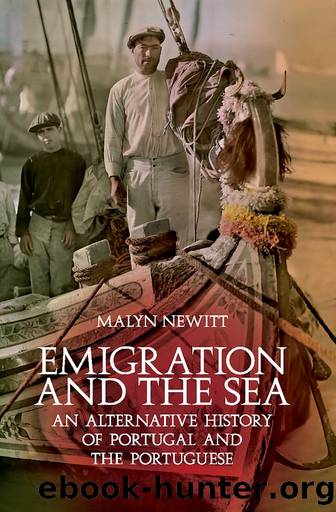Emigration and the Sea by Newitt Malyn;Newitt M D D;

Author:Newitt, Malyn;Newitt, M D D; [Newitt, Malyn;Newitt, M D D;]
Language: eng
Format: epub
ISBN: 9780190263935
Publisher: OxfordUP
Published: 2015-09-15T00:00:00+00:00
A society of women
Maria Baganha states in her article âPortuguese Emigration after World War IIâ that there is âan assumption that Portuguese emigration is essentially an international labor flow, which has changed according to the demand for labor in the international marketâ. Caroline Brettell, however, has argued that migration cannot be understood except in terms of the life choices made by individuals, which are often complex and are seldom as mechanistic as phrases like âinternational labour flowâ would suggest.
From the middle of the nineteenth century until 1960 the large majority of emigrants were men from the rural areas of northern Portugal and the islands. The consequences of this exodus for Portuguese society and for Portuguese culture were profound. It became quite common for married women to be left to manage the rural smallholdings and to bring up families on their ownâwith the help, if they were lucky, of remittances from husbands or sons overseas. Even when men did not emigrate to the Americas, they often left the villages to seek work in the towns, to go as seasonal labour to Spain or Morocco or to sail with the White Fleet to the Grand Banks and the Greenland cod fisheries.
Caroline Brettell summarised the impact of this pattern of migration: âHistorically male-biased emigration can ⦠be linked to such phenomena as delayed marriage for women, permanent spinsterhood, high rates of illegitimacy, uxorilocal residence patterns, female heirship, and unusually lengthy birth intervals.â43 It was quite common for many Portuguese women to remain unmarriedâthough this may have been due less to a shortage of men to marry than to the pressure on women not to have families and force the further division of the family farms. In Portugal in the 1860s 21 per cent of women over fifty remained unmarried, and this figure was still around 16 per cent in 1960. In some rural parishes, however, the numbers were much higher. The figures given by Caroline Brettell for the parish of Santa Eulalia in Minho show that 33.9 per cent of women over fifty in the decade 1860â69 were unmarried, with little change in the succeeding hundred yearsâthe figure for 1950â59 being 31.2 per cent.44
As a result of the absence of men, women occupied a very prominent place in rural society in northern Portugal, making the important family decisions, bringing up children and managing family property. The downside of this was cultural isolation resulting from the very low level of education available for women and the various laws, particularly during the period of the Estado Novo, which prevented women from occupying positions of responsibility in the wider society. Many studies have emphasised the hardship that male emigration brought to the women left behind, reflected in the titles that Caroline Brettell gave to two of her books, We Have Already Cried Many Tears and Men Who Migrate, Women Who Wait; but few have expressed it so eloquently as Alfred Lewis. José, the hero of his novel Home is an Island, asks his mother if she would rather he stayed in the village.
Download
This site does not store any files on its server. We only index and link to content provided by other sites. Please contact the content providers to delete copyright contents if any and email us, we'll remove relevant links or contents immediately.
Room 212 by Kate Stewart(4716)
The Crown by Robert Lacey(4556)
Endurance: Shackleton's Incredible Voyage by Alfred Lansing(4474)
The Iron Duke by The Iron Duke(4099)
The Rape of Nanking by Iris Chang(4003)
Killing England by Bill O'Reilly(3889)
Joan of Arc by Mary Gordon(3767)
Say Nothing by Patrick Radden Keefe(3696)
I'll Give You the Sun by Jandy Nelson(3249)
Shadow of Night by Deborah Harkness(3161)
Hitler's Monsters by Eric Kurlander(3142)
Blood and Sand by Alex Von Tunzelmann(3040)
Mary, Queen of Scots, and the Murder of Lord Darnley by Alison Weir(3033)
Darkest Hour by Anthony McCarten(3008)
Margaret Thatcher: The Autobiography by Thatcher Margaret(2962)
Eleanor & Park by Rainbow Rowell(2926)
Red Famine: Stalin's War on Ukraine by Anne Applebaum(2804)
Book of Life by Deborah Harkness(2705)
The One Memory of Flora Banks by Emily Barr(2673)
